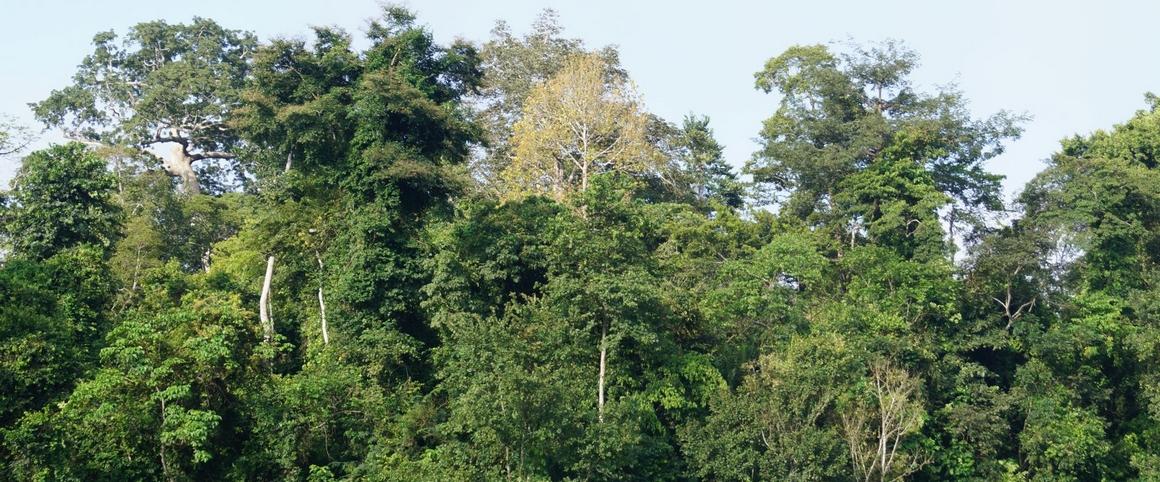Results & impact 10 October 2025
- Home
- Press area
- Press releases
- Natural regeneration of tropical forests
Natural regeneration of tropical forests is faster than anticipated

Secondary forest in the Agbo classified forest, Ivory Coast, 30 years after abandoning farming © Anny E N’Guessan
Although there is a vital need to end deforestation, tropical forests can potentially regenerate naturally and rapidly on abandoned farmland. These forests, known as secondary forests, cover vast areas in many tropical countries. They have the potential to contribute to local and global ecosystem restoration objectives, while providing numerous ecosystem services, from biodiversity conservation to water quality improvement and carbon sequestration.
To better understand the mechanisms of this natural tropical forest regeneration, researchers have modelled the regeneration trajectories of more than 2200 secondary forest plots across Africa and South America. The team, working within the 2ndFOr network, comprises 80 researchers from all over the world, including three from Ivory Coast and two from CIRAD. The study, published in Science, was coordinated by Wageningen University (Netherlands) and CIRAD (France).
Behind this groundbreaking work, a French-Ivorian partnership
Ivory Coast has lost more than 10 million hectares of forest since the 1960s. Faced with the degradation of its forest resources, the country is accelerating its fight against deforestation and its forest restoration actions. To this end, the researchers from Ivory Coast and CIRAD working within the DynRecSe* project have developed an innovative methodology to measure and predict forest regeneration.
“The models we have developed enable us to understand and compare the different dimensions of forest ecosystem recovery”, says Justin Kassi, head of the DynRecSe project and professor at Félix Houphouët-Boigny University. “We have used these models to quantify carbon storage trajectories, then to estimate the potential for the regeneration of biodiversity and commercial forest resources in secondary forests in Ivory Coast and West Africa”, continues Anny Estelle N’Guessan, a researcher at Félix Houphouët-Boigny University.
Efforts to build networks with scientists from all over the world then made it possible to expand the study fields, but also the dimensions of regeneration: soils, ecosystem functioning, forest structure, and finally, forest diversity and composition. Amani Konan Bienvenu, an Ivorian doctoral student from Jean Lorougnon Guédé University (Daloa, Ivory Coast), hosted by CIRAD in the Forests and Societies unit in Montpellier, is one of the pioneers: “Conventional methodologies are based on one or two dimensions. In this work, we simultaneously examined 12 different dimensions, and observed how they interact with one another. This is a major step forward, not only for research, but also to support forest restoration policies”.
Rapid regeneration of tropical forests under certain conditions
Twenty years after agricultural practices are abandoned, forests that grow back naturally recover 80% of their soil fertility, structure and functioning, and diversity in relation to old-growth forests. This is surprisingly fast, given the complexity of tropical forest ecosystems.
According to the authors, this rapid forest regeneration is explained in particular by the seeds still present in soils not affected by intensive agriculture, as well as by the relatively productive growth conditions in the hot and humid tropics. Géraldine Derroire, a tropical forest ecologist at CIRAD and head of the ARBOCEL site in French Guiana, which provided data for this project, says: “Some forest attributes recover more quickly than others. For example, 90% of soil fertility is typically restored in less than 10 years. In comparison, it takes 20 to 60 years to restore 90% of the species diversity found in old-growth forests”.
Affordable nature-based solutions
In view of the rapid regeneration of secondary forests when the conditions are right, the scientists advocate natural restoration practices that do not require heavy investment, are effective and provide multiple co-benefits. These nature-based solutions are fully in line with the United Nations Sustainable Development Goals, the United Nations Decade on Ecosystem Restoration (2020-2030), the United Nations Framework Convention on Climate Change (COP26) and the Convention on Biological Diversity (COP15).
According to Bruno Hérault, a specialist in tropical forest landscapes at CIRAD: “There is no silver bullet for forest restoration. A combination of approaches is needed in most tropical territories. Passive natural regeneration has its place in conjunction with other more active solutions (assisted natural regeneration, agroforestry, forest plantations), depending on the local objectives. Our work in Ivory Coast shows that a whole range of solutions can be mobilised and co-developed, according to the social, economic, historical and ecological contexts of the territories targeted”.
* Dynamics of Regeneration of Ecosystem Services, funded under C2D AMRUGE
References
Poorter L, Craven D, … & Hérault B 2021. Multi-dimensional resilience of tropical forests. Science. doi:10.1126/science.abh3629
N'Guessan AE, N'dja JK, … & Hérault B, 2019. Drivers of biomass recovery in a secondary forested landscape of West Africa. Forest Ecology and Management 433: 325-331.
Amani BHK, N'Guessan AE, ... & Hérault B, 2021. The potential of secondary forests to restore biodiversity of the lost forests in semi-deciduous West Africa. Biological Conservation 259: 109154.
Doua-Bi Y, Zo-Bi IC, ... & Hérault B, 2021. Taking advantage of natural regeneration potential in secondary forests to recover commercial tree resources in Côte d'Ivoire. Forest Ecology and Management 493: 119240.



























